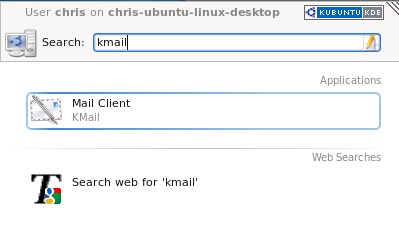
For three years, I’ve been a happy Gnome user. I’m still a happy Gnome user, but I’ve heard some buzz about KDE 4 lately and figured I’d give it a try.
When I made the jump to the Linux world by installing Mandriva 2006 a few years ago, KDE 3 was the desktop environment in which I took my first steps. After moving to Fedora a few months later, however, I began using Gnome, mostly because it was the default environment and at that time I didn’t know how to install anything else.
Since switching to Ubuntu beginning with the 7.04 release, I’ve stuck with Gnome and haven’t looked back–until yesterday, when I installed KDE 4 on my Ubuntu 8.10 system using the kubuntu-desktop package.
Now that I’ve spent a day using KDE, I thought I’d make a list of what I like and dislike so far.
The Good
Maybe it’s only because of its novelty, but KDE 4 looks nice to me–and it’s definitely better than KDE 3, which seemed aesthetically dated even in 2006. I wouldn’t call it gorgeous, but it’s not bad. The splash screen, with its fade-in effects, is especially impressive.
I am also impressed by the search feature in the main menu. In order to find an application, I can type its name or a description and it will automatically appear:

This is a pretty cool feature, and one that Gnome would do well to emulate.
Another nice move on the part of KDE developers was the creation of system-configuration utilities that don’t exist in Gnome, at least by default. For instance, KDE comes with a graphical editor for the grub menu, something lacking in regular Ubuntu for quite a while. Stuff like this is simple, but can be a real help to users who are afraid of hand-editing configuration files.
Finally, although it sort of reminds me of Microsoft’s efforts to make Windows revolve around Internet Explorer, I think I like how KDE’s web browser, Konqueror, can be used not only to browse Web pages, but to launch applications and manage files as well. It’s nice to have everything in one place.
The Bad
I’ve spent the day using KMail, KDE’s default mail client, and have been less than impressed. My chief grievances include:
it only works with Gmail if I set it to remember my password, which I would prefer not to do
no support for HTML messages (at least, I haven’t yet discovered how to enable it)
no calendar integration
Maybe I’ll learn to like KMail more if I use it a bit longer, but right now, I’m struggling to keep myself from going back to Evolution.
While Konqueror’s ability to manage files and launch applications is nice, it’s only barely cutting it as a web browser. Sites that use a lot of JavaScript are very slow, and the WordPress composer is badly broken. These might be problems that I could fix with a little work, but for the time being, I’m using Firefox for browsing the Internet.
KDE 4 also seems to have bastardized the concept of a desktop as it has existed in every major GUI-equipped operating system since the 1980s. Desktop icons can be placed only on part of the screen, in a sort of folder through which I have to scroll in order to see all the contents . Although this might be a nice way of encouraging users to keep their desktops clean, it’s a pretty silly idea. What were the developers really hoping to achieve by taking away the desktop?
Conclusions
At this point, I’ve yet to reach a verdict on whether or not I like KDE 4. It has some nice features, but I’m having a hard time getting over KMail’s lackluster performance and the absence of a normal desktop. I’ve made a commitment to continue using KDE until the end of the week, however, at which time I’ll write an update containing a more thorough outline of my experience.
WorksWithU is updated multiple times per week. Don’t miss a single post. Sign up for our RSS and Twitter feeds (available now) and newsletter (coming in 2009).
About the Author(s)
You May Also Like


